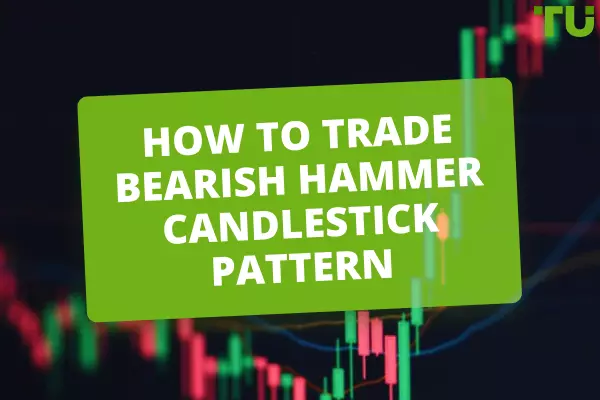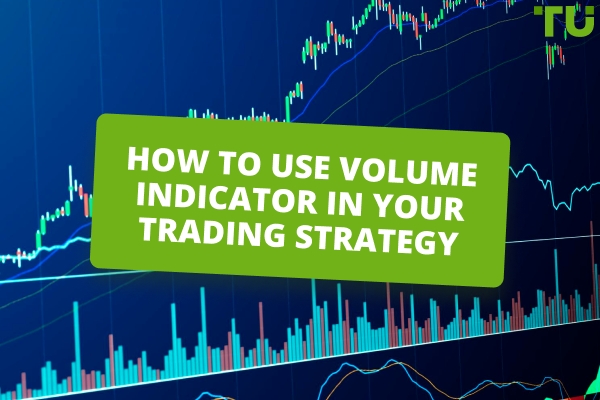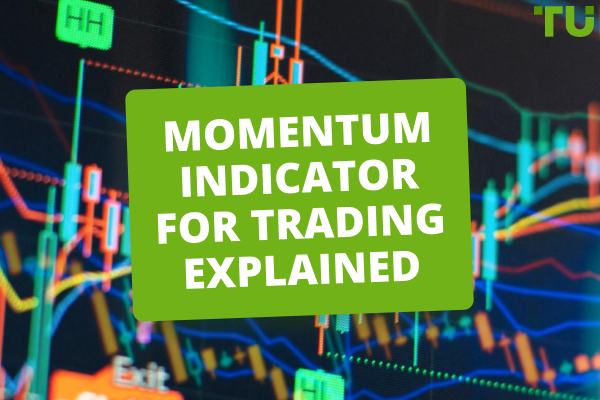What Is A Megaphone Pattern, And How To Trade It?
A Megaphone Pattern, characterized by its broadening swings, captures market volatility and sentiment shifts.
-
Features: Reflects increasing volatility, Applicable across various assets
-
Pros: Clear visualization of market dynamics, Structured risk and reward parameters
-
Cons: Requires experienced interpretation, Can be subjective and context-dependent
Chart patterns are a natural way to add structure to the developing dynamics of financial asset prices, simplify the understanding of market trends, and add systematicity to trading decisions. That is why patterns are widely and usefully applied by traders. Yet, the problem lies in the complexity and the subtlety of these patterns.
This article will guide traders through the intricacies of one such pattern: the Megaphone. Through a deeper understanding of this formation, traders can harness its potential for predicting trend continuations, thus optimizing their trading strategy for better risk-adjusted returns.
-
What is a megaphone pattern in trading?
A megaphone pattern in trading is a reversal pattern characterized by higher highs and lower lows that expand over time, indicating increasing volatility.
-
What Is a Broadening Top?
Broadening top is another name for the megaphone pattern in trading.
-
Is Megaphone Pattern Bearish or Bullish?
The Megaphone Pattern can be both bearish or bullish, depending on the prevailing trend and where the price breaks out from the formation.
-
Is pattern trading effective?
Pattern trading is considered effective by many traders as it provides structured entry and exit points, but its effectiveness can vary widely among individuals and market conditions.
Megaphone pattern basics
Like the instrument it's named after, the Megaphone pattern amplifies the signal on a chart, yet its identification is not without its nuances. Context is king when discerning this pattern, and the trader’s interpretive skill plays the key role. There’s a subjective art to spotting a Megaphone pattern - mistaking noise for signal can prove costly.
By examining the included chart, one can see a classic scenario unfold. During a downtrend, traders may observe what appears to be a false rally - a higher high that seems to suggest a bullish reversal.
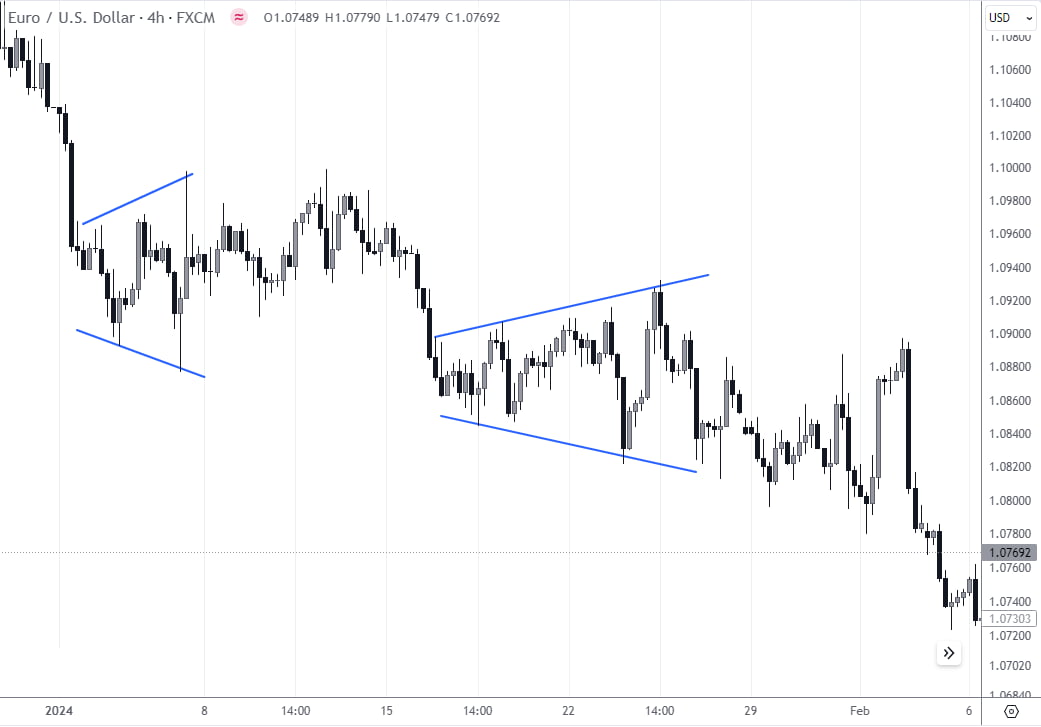
Two examples of Megaphone pattern in a downtrend
However, as depicted in the chart, this peak is merely the upper boundary of a Megaphone pattern, hinting instead at the persistence of the downtrend. By focusing on this continuation, traders can capitalize on an attractive profit/risk ratio, remaining aligned with the prevailing market momentum.
With relation to fundamental analysis, the appearance of the Megaphone pattern means a state of prolonged uncertainty after a strong trend, when the price starts to be rocked by swing traders, and then the pattern gradually expands by opening new positions.
Best Forex Brokers

Rules to trade megaphone pattern
The Megaphone pattern provides a strategic vantage point for entry during an unfolding trend.
Mastery of this pattern enables traders to set precise entries and optimize their trade execution. Here, we discuss two critical entry strategies within the confines of a bearish trend.
-
The first method is to initiate a sell at the top boundary of the Megaphone pattern. This approach hinges on the pattern's upper resistance line, which typically repels price rallies during a downtrend. Traders wait for the price to touch or approach this line before entering a short position, betting on the trend to resume its downward course.
-
The second strategy involves selling from the testing of the pivot line. The pivot line acts as the spine of the Megaphone pattern, offering a secondary point of reference for bearish entries. When (and if) the price retraces to this central line and shows signs of rejection, it signals a potent opportunity to enter a sell trade, anticipating the continuation of the bearish trend.
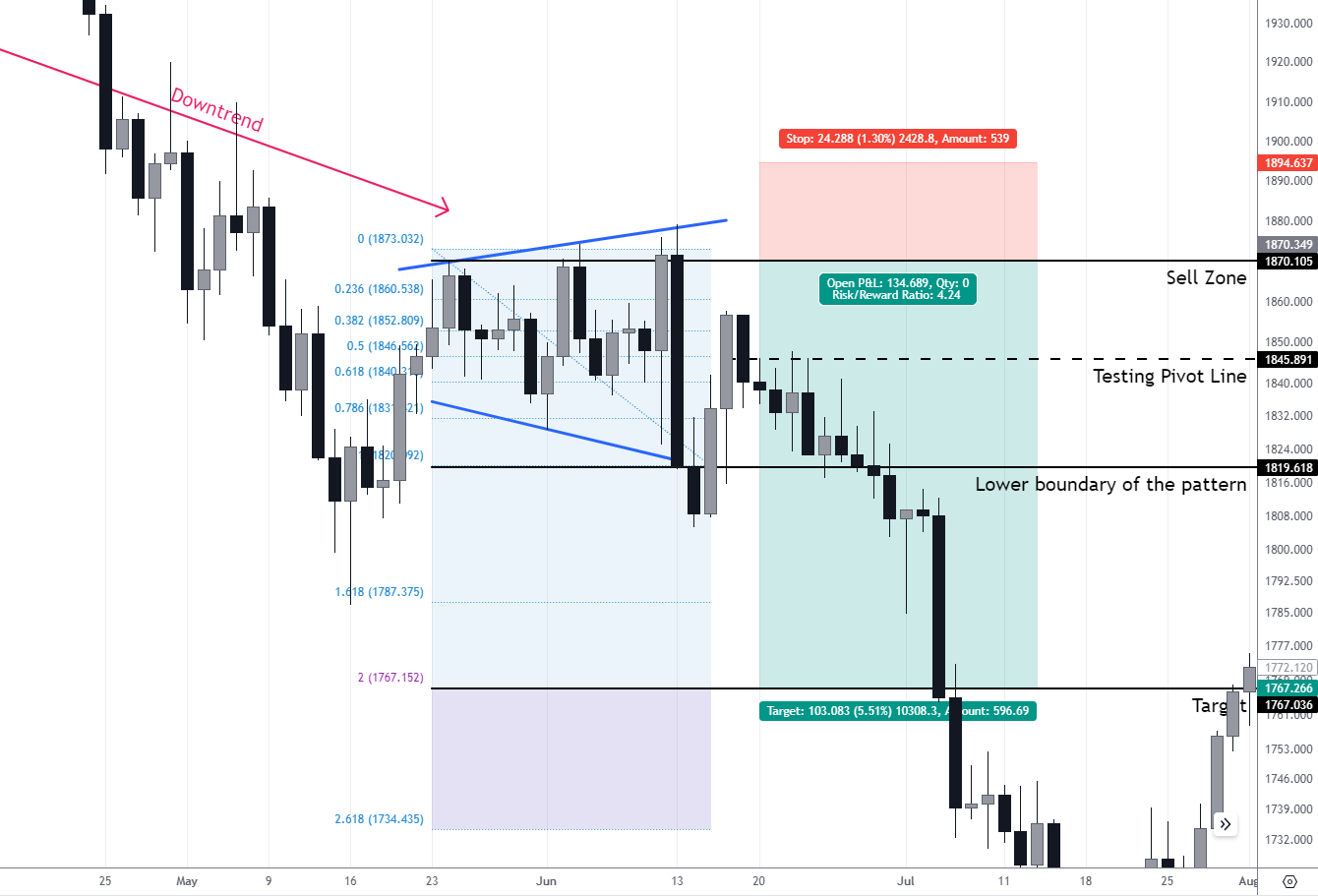
How to trade Megaphone pattern
Both strategies come with a common goal: to capitalize on the potential resumption of the downtrend signified by the Megaphone pattern. By employing these tactics, traders can harness the predictive nature of the pattern, securing positions aligned with the market's momentum.
What is the price target of the Megaphone pattern?
The price target of a Megaphone pattern is derived from its structural height—the distance between the pattern's highest and lowest points. Once a breakout occurs, traders project this height from the point of breakout to establish a potential target. If the breakout is downwards, the target is set below the breakout point at a distance equal to the pattern’s height.
Conversely, for an upward breakout, the target is projected above. This method offers a measurable and objective way to gauge profit potential, balancing ambition with the statistical tendencies observed within the pattern’s behavior.
Example 1. Megaphone pattern on stocks
The Megaphone pattern frequently emerges to signal potential reversals or continuations. Take, for instance, NVIDIA Corporation (NVDA), where we observe two distinct cases of the pattern.
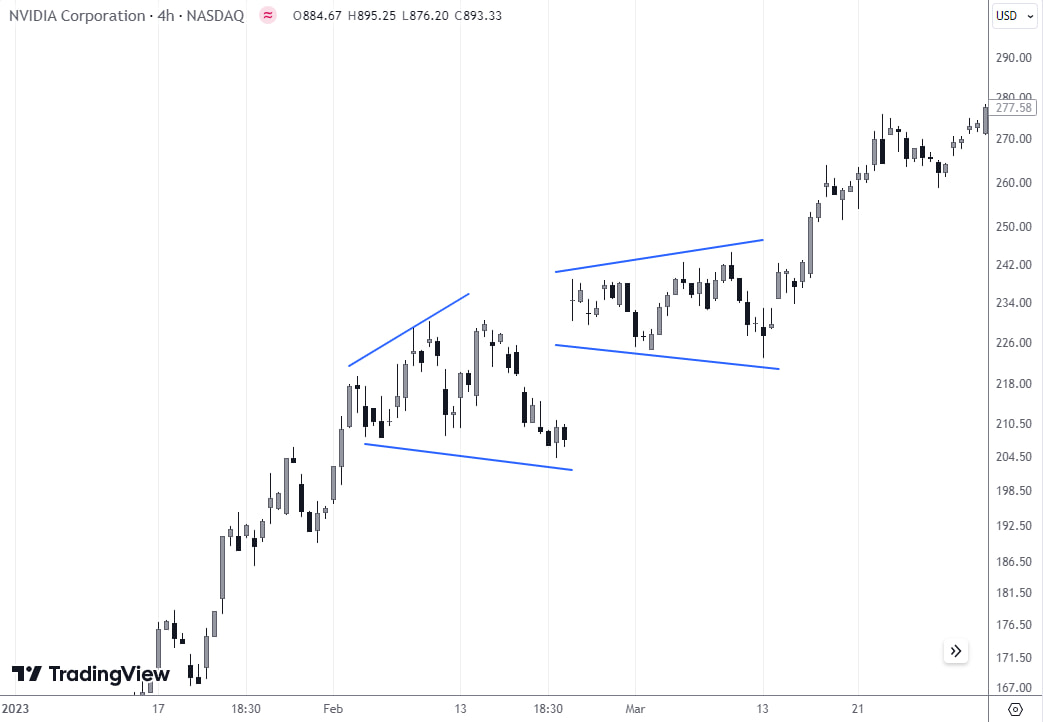
Example of Megaphone pattern on NVDA stock chart
In the first case, the pattern materializes amidst an uptrend, with NVDA's price action expanding outwards, creating higher highs and lower lows. This classical Megaphone formation suggests increasing market volatility and indecision, leading to a wider price range as the stock climbs.
The second instance unveils itself as NVDA's share price experiences a pullback, forming a smaller Megaphone. This variation may imply a potential reversal or a consolidation phase before the trend resumes. For traders, these formations provide tactical entry and exit points, allowing them to navigate the stock's volatility with greater confidence.
Example 2. Megaphone pattern on crypto market
The crypto market, known for its sharp volatility, presents a fertile ground for the Megaphone pattern, as illustrated in the Ethereum to U.S. Dollar (ETH/USD) pairing. The pattern is distinctly visible, marked by expanding swing highs and lows that encapsulate the essence of market indecision.
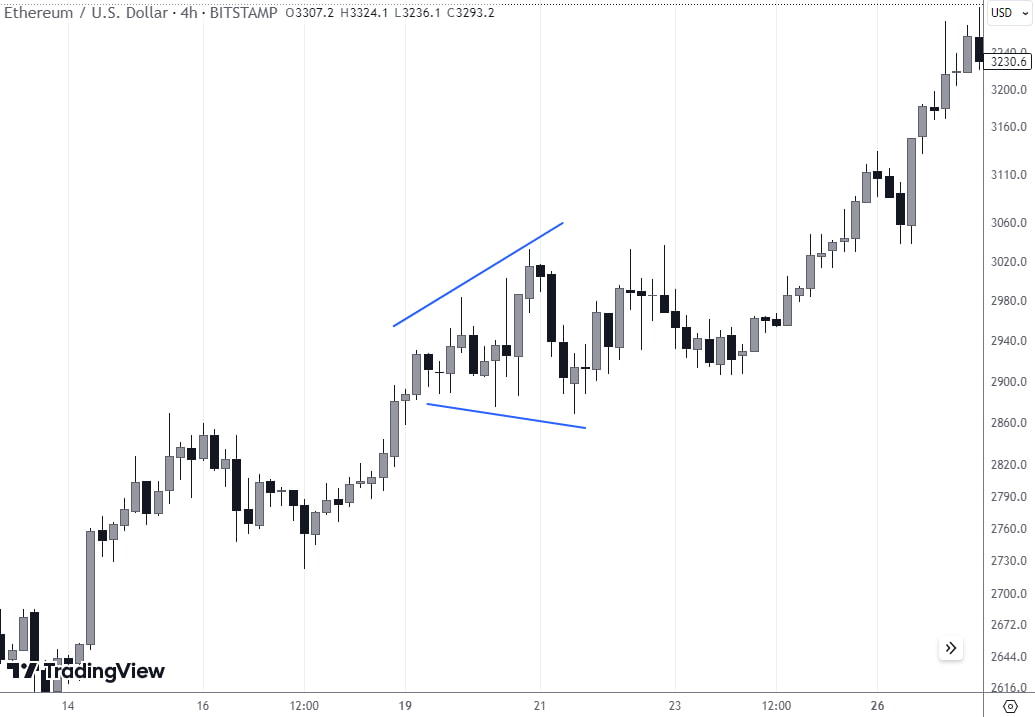
Example of Megaphone pattern from crypto market
In this particular ETH/USD chart, the Megaphone pattern unfolds within an overall uptrend, signifying the market's struggle between bullish sentiment and intermittent profit-taking. The widening nature of the pattern reflects increasing uncertainty and heightened market dynamics, which is characteristic of the cryptocurrency environment.
Traders keeping a watchful eye on such patterns in the crypto market can anticipate potential trend reversals or continuations. Megaphone pattern, in particular, suggests a larger battleground for bulls and bears, signaling that significant volatility and trading opportunities are afoot.
Example 3. Testing the Megaphone pivot line
The Euro/U.S. Dollar (EUR/USD) chart offers a clear illustration of how the Megaphone's pivot line operates within this context.
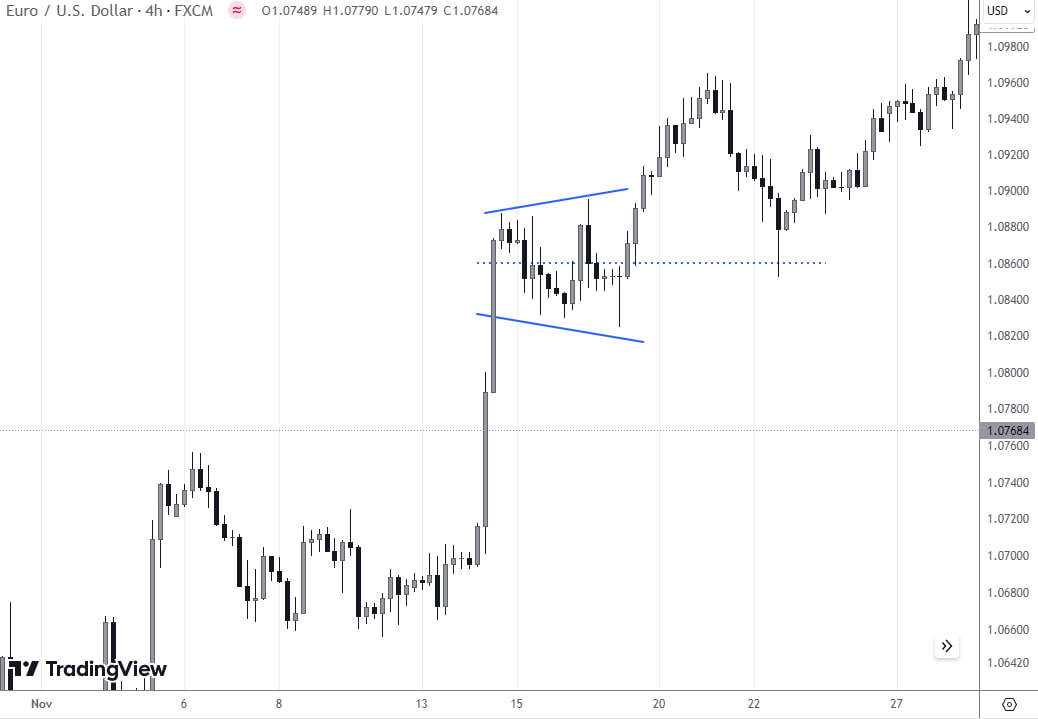
Example of Megaphone pattern from Forex market
As depicted, the pivot line - drawn between the swing highs and lows - represents a crucial axis of symmetry within the Megaphone formation. In this instance, the EUR/USD price tests the pivot line multiple times, signaling indecision. A definitive pivot line test occurs when the price touches or approaches this central line and then reverses course, honoring the pattern's parameters.
This test can act as a confirmation signal for traders, suggesting that the existing trend may persist. A successful pivot line test often reinforces the validity of the pattern and can be used to refine entry and exit strategies, providing a systematic approach to navigating the Forex market's fluctuations.
Example 4. Failed Megaphone pattern
Even the most well-defined patterns can sometimes fail to follow through on their predictive promises. The chart in question shows a scenario where the Megaphone pattern did not result in the expected continuation. Initially, the pattern's bottom support line served as a platform from which price bounced upwards, typical of a Megaphone in a bullish trend.
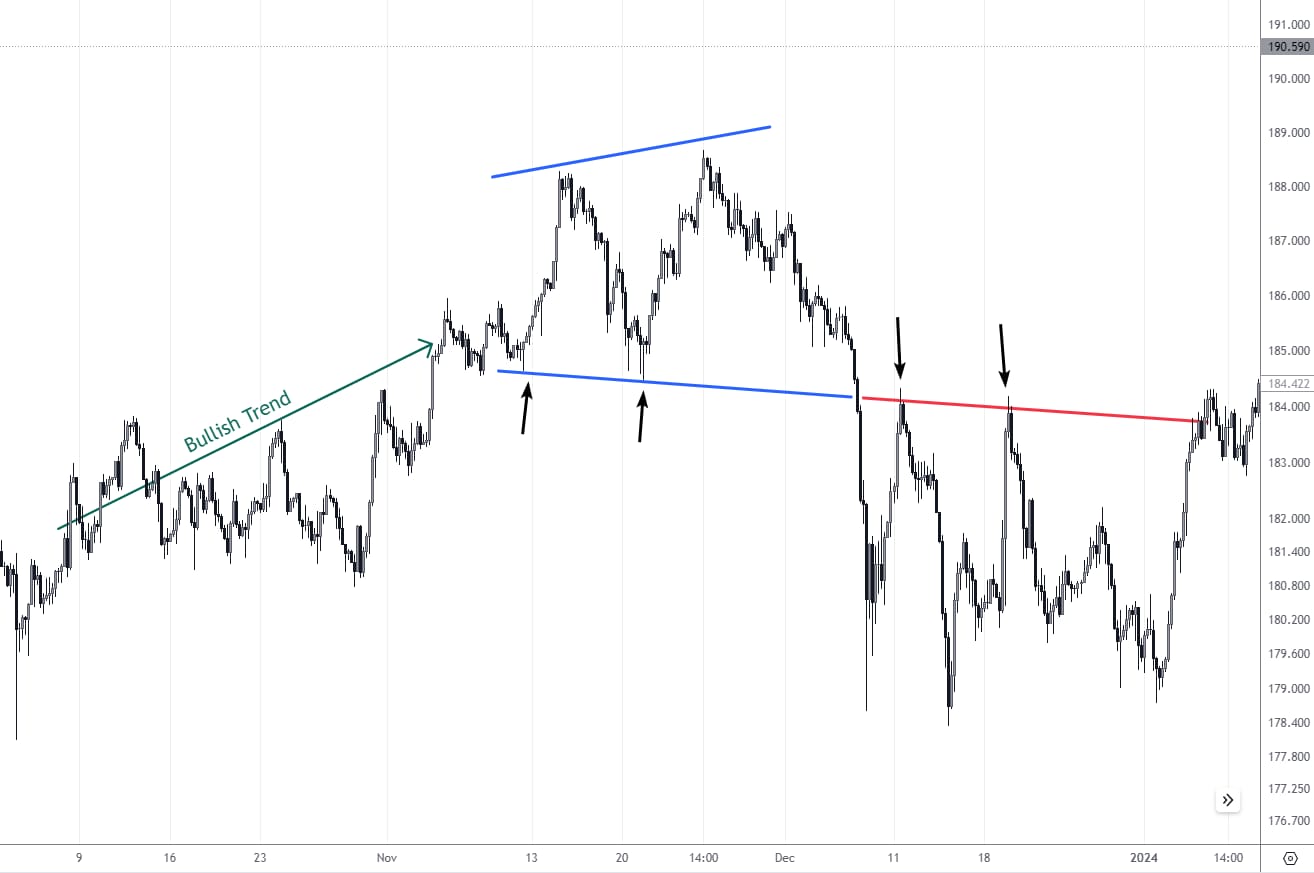
Example of Megaphone pattern that failed
However, following a significant downturn, the same line that once provided support for the price now becomes a ceiling, resisting any upward movement and flipping its role to become resistance. This shift in market sentiment indicates that the forces which previously propelled the price upwards have been overcome by selling pressure, signaling a change in trend dynamics.
A failed Megaphone pattern such as this serves as a crucial reminder for traders: while patterns can provide a structure to market movements, they are not infallible. Risk management and contingency planning are essential components of any trading strategy.
A few practical remarks
-
Megaphone pattern is usually formed for quite a long time, local max/min are possible inside the zone, not reaching the boundaries.
-
The older the timeframe, the more reliable the Megaphone.
-
A confident signal to open a position occurs only at a true breakout and consolidation beyond the boundaries of the pattern.
-
It is necessary to control the dynamics of volumes: at the moment of breakdown of the potential pattern boundary there should be maximum activity.
-
A pattern with a small amplitude is better to skip altogether, a larger one can be traded on retests of the boundaries, but frequent "false" breakdowns are possible - at the moment of price approach to the boundary, strong news may well break this pattern.
-
To confirm the entry point, it is recommended to combine the target levels with the Fibonacci level from the last movement.
Should I trade the Megaphone pattern?
Trading the Megaphone pattern is contingent on a trader's skill in pattern recognition and risk tolerance. Its appearance in varying market conditions - from stocks to Forex and cryptos - provides multiple use cases. For instance, it can signal a reversal in a downtrend or herald the continuation of an uptrend.
However, its efficacy is not universal; it thrives in markets with high volatility and liquidity. Traders must evaluate their own strategies and consider whether the Megaphone pattern aligns with their goals and trading style before incorporating it into their analysis.
Benefits of Using Megaphone Pattern
Utilizing the Megaphone pattern in trading encompasses a list of pros that can be leveraged for strategic advantage:
-
Visualization of Market Dynamics: The pattern clearly outlines increasing volatility, a valuable indicator for potential significant price movements.
-
Precise Risk Management: The ability to set concrete price targets and stop-loss levels based on the pattern’s parameters enhances risk control.
-
Adaptability Across Markets: Its applicability in various financial environments, from stocks to Forex and cryptocurrencies, demonstrates the pattern's adaptability.
-
Clear Trade Structuring: Defined entry and exit points facilitate strategic planning and execution of trades, essential for disciplined trading.
-
Indication of Sentiment Shifts: The Megaphone pattern can signal changes in market sentiment, allowing traders to position themselves accordingly.
These benefits make the Megaphone pattern a potent tool for traders who understand its implications and can integrate it effectively within their market strategies.
Why not to trade Megaphone pattern
While the Megaphone pattern has its advantages, there are several cons that traders must consider:
-
Subjective Interpretation: Identifying the pattern accurately requires experience, as misinterpretation can lead to incorrect trading decisions.
-
Necessity for Contextual Analysis: Understanding the market context is crucial, as the pattern alone does not provide all the answers.
-
Potential for Lower Risk-Reward: Due to potentially wider stop losses required by the pattern's volatility, the risk-reward ratio might be less favorable.
-
Dependence on Liquidity: In thinly traded markets, the reliability of the pattern can diminish, leading to false breakouts or breakdowns.
-
Sensitivity to Market News: Economic events can disrupt the technical formation, invalidating the pattern abruptly.
These drawbacks require traders to exercise caution, ensuring they are not solely relying on the pattern without consideration of other market factors and risk management techniques.
Expert Tip
“Always bear in mind, the Megaphone pattern speaks volumes about market sentiment and potential volatility. But like any market dialogue, it requires a keen ear. Filter out the noise with rigorous analysis and disciplined risk management.”
Summary
The Megaphone pattern offers a strategic lens to view market volatility, providing clear signals for entry and exit points. Yet, its effective use demands a nuanced understanding of market context and careful risk assessment. Despite its potential, traders should approach with caution, considering both its advantages and limitations within their comprehensive trading strategy.
Glossary for novice traders
-
1
Ethereum
Ethereum is a decentralized blockchain platform and cryptocurrency that was proposed by Vitalik Buterin in late 2013 and development began in early 2014. It was designed as a versatile platform for creating decentralized applications (DApps) and smart contracts.
-
2
Copy trading
Copy trading is an investing tactic where traders replicate the trading strategies of more experienced traders, automatically mirroring their trades in their own accounts to potentially achieve similar results.
-
3
CFD
CFD is a contract between an investor/trader and seller that demonstrates that the trader will need to pay the price difference between the current value of the asset and its value at the time of contract to the seller.
-
4
Cryptocurrency
Cryptocurrency is a type of digital or virtual currency that relies on cryptography for security. Unlike traditional currencies issued by governments (fiat currencies), cryptocurrencies operate on decentralized networks, typically based on blockchain technology.
-
5
Leverage
Forex leverage is a tool enabling traders to control larger positions with a relatively small amount of capital, amplifying potential profits and losses based on the chosen leverage ratio.
Team that worked on the article
Vuk stands at the forefront of financial journalism, blending over six years of crypto investing experience with profound insights gained from navigating two bull/bear cycles. A dedicated content writer, Vuk has contributed to a myriad of publications and projects. His journey from an English language graduate to a sought-after voice in finance reflects his passion for demystifying complex financial concepts, making him a helpful guide for both newcomers and seasoned investors.
Dr. BJ Johnson is a PhD in English Language and an editor with over 15 years of experience. He earned his degree in English Language in the U.S and the UK. In 2020, Dr. Johnson joined the Traders Union team. Since then, he has created over 100 exclusive articles and edited over 300 articles of other authors.
Mirjan Hipolito is a journalist and news editor at Traders Union. She is an expert crypto writer with five years of experience in the financial markets. Her specialties are daily market news, price predictions, and Initial Coin Offerings (ICO).





